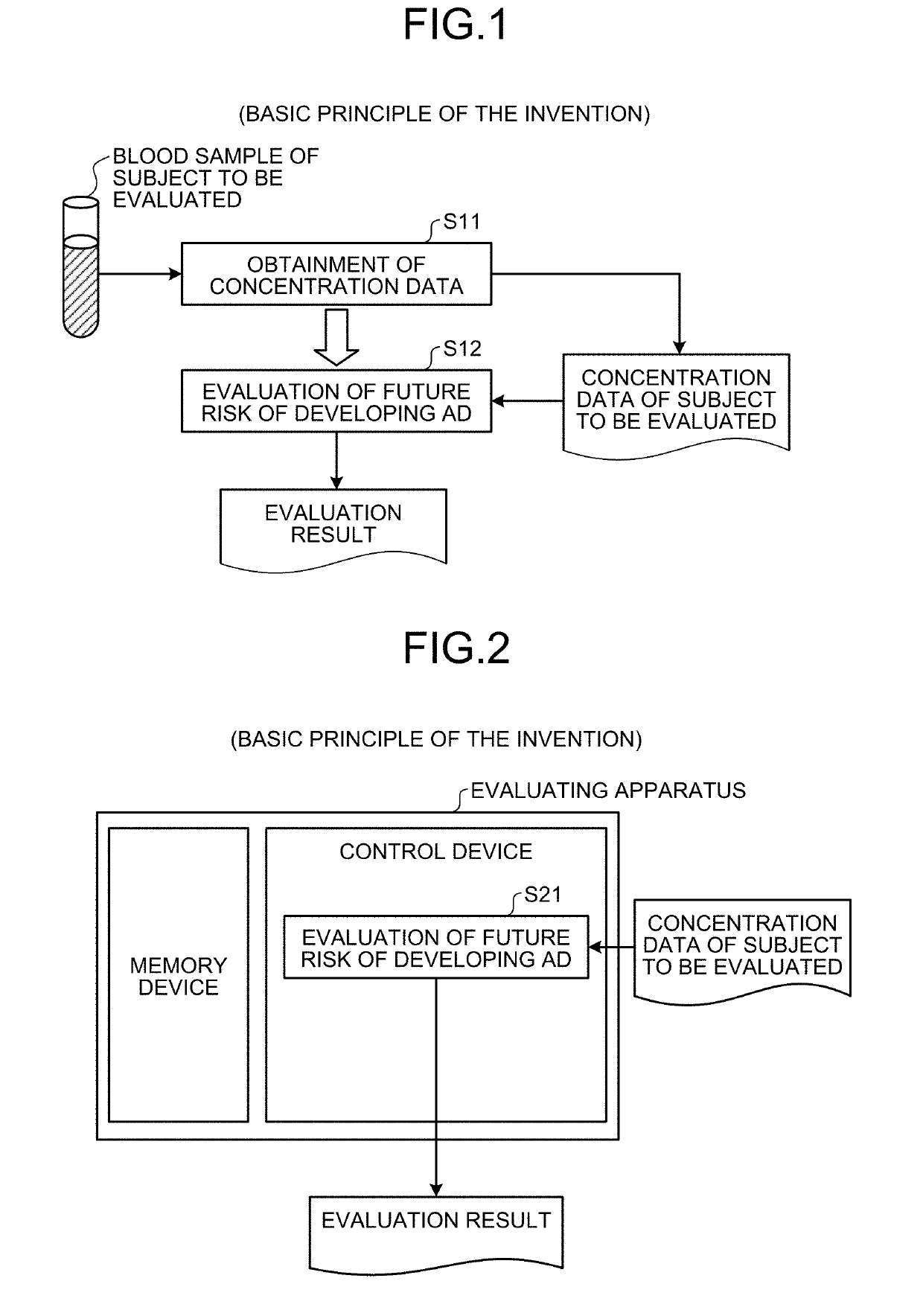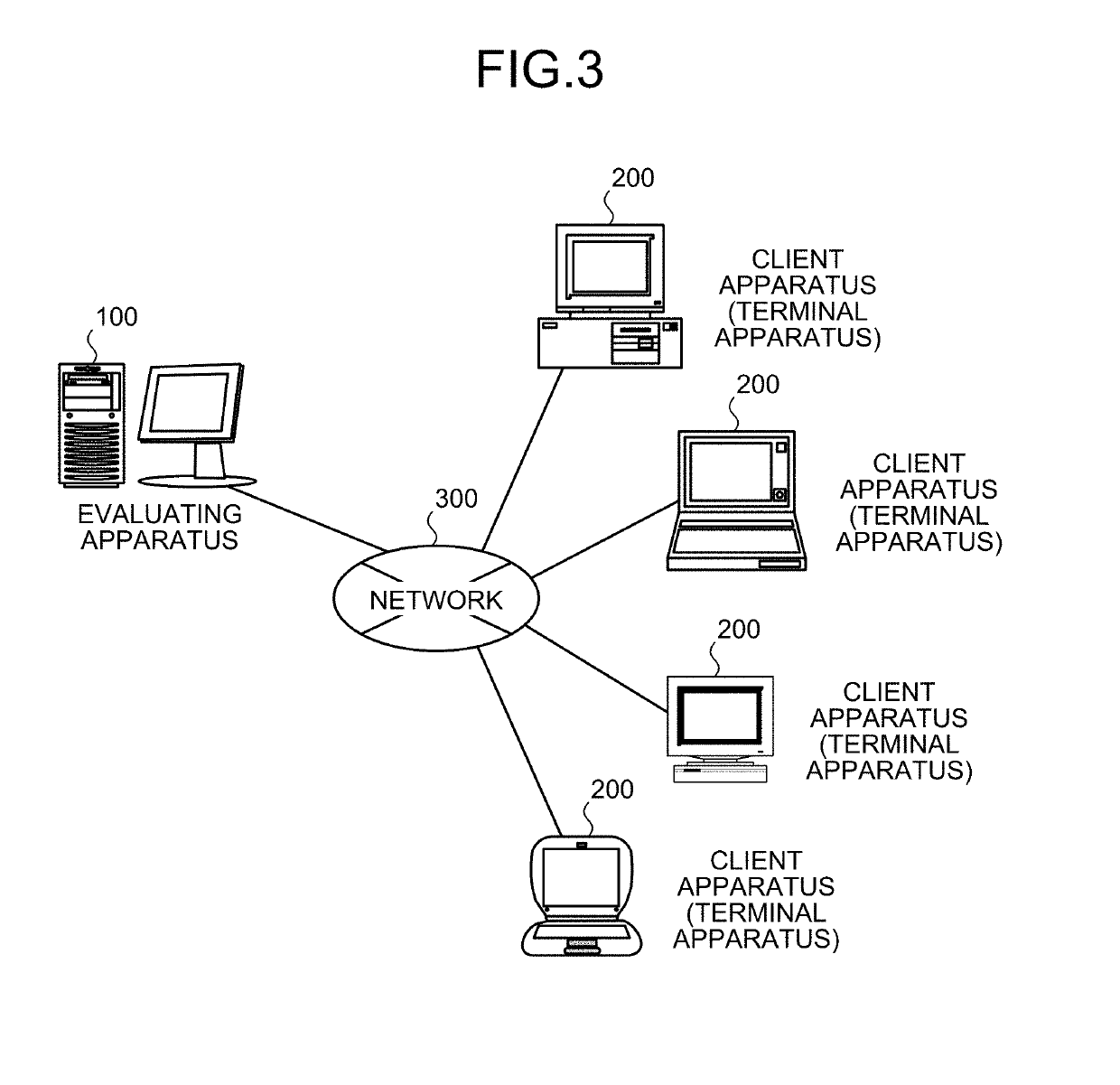Evaluating method for future risk of developing alzheimer's disease
a terminal apparatus and future risk technology, applied in the direction of material analysis, biological material analysis, instruments, etc., can solve the problems of inability to establish the disease modifying therapy necessary for radical cure, inability to independently use any one of the diagnostic imaging techniques mentioned above as a definitive diagnosis method, and inability to find candidate medicines exerting remarkable effects
- Summary
- Abstract
- Description
- Claims
- Application Information
AI Technical Summary
Benefits of technology
Problems solved by technology
Method used
Image
Examples
first embodiment
[0033]1-1. Outline of First Embodiment
[0034]Here, an outline of the first embodiment will be described with reference to FIG. 1. FIG. 1 is a principle configurational diagram showing a basic principle of the first embodiment.
[0035]First, concentration data on a concentration value of at least one of the 23 kinds of amino acids and the 7 kinds of amino acid related metabolites (a substance or substances arbitrarily selected from the 23 kinds of amino acids and the 7 kinds of amino acid related metabolites) contained in the blood (including, for example, plasma or serum) extracted from a subject to be evaluated (for example, an individual such as animal or human) having MCI is obtained (Step S11). In the present description, the subject to be evaluated having MCI is, for example, a subject diagnosed as MCI according to an existing diagnostic criterion for MCI (for example, “Petersen, et al., Arch Neurol (1999) 56(6): 760.; Mild cognitive impairment: clinical characterization and outco...
second embodiment
[0057]2-1. Outline of the Second Embodiment
[0058]Here, outlines of the second embodiment will be described in detail with reference to FIG. 2. FIG. 2 is a principle configurational diagram showing a basic principle of the second embodiment. In the description of the present second embodiment, description duplicating that of the first embodiment is sometimes omitted.
[0059]A control device evaluates the future risk of developing AD for the subject having MCI using the concentration value of at least one of the 23 kinds of amino acids and the 7 kinds of amino acid related metabolites included in the previously obtained concentration data of the subject (for example, an individual such as animal or human) on the concentration value of at least one of the 23 kinds of amino acids and the 7 kinds of amino acid related metabolites in blood (step S21). In this way, reliable information that may be helpful in knowing the future risk of developing AD can be provided for purpose of avoiding the...
example 1
[0100]The blood samples of aged persons diagnosed as MCI and the information on dementia diagnosis made after three to five years from the sampling were obtained (from a total of 30 people). Two persons who developed dementia different from AD were excluded and the rest of 28 persons were determined as the subjects. In accordance with the dementia diagnosis information, the 28 persons were classified into an AD group and a non-AD group. The blood samples were measured by the measuring method (A) to determine the blood concentrations (mol / ml) of the 23 kinds of amino acids (α-ABA, Ala, Arg, Asn, Cit, Glu, Gln, Gly, His, Ile, Leu, Lys, Met, Orn, Phe, Pro, Ser, Thr, Trp, Tyr, Val, Cysteine, Taurine). Furthermore, the same blood samples were measured by the above-mentioned measuring method (A) to determine the blood concentrations (mol / ml) of the two kinds of amino acid related metabolites (L-3-Aminoisobutyric acid, N8-Acetylspermidine). The method proposed in 1995 by Petersen et al., f...
PUM
| Property | Measurement | Unit |
|---|---|---|
| concentration | aaaaa | aaaaa |
| diagnostic imaging | aaaaa | aaaaa |
| positron emission tomography | aaaaa | aaaaa |
Abstract
Description
Claims
Application Information
 Login to View More
Login to View More - R&D
- Intellectual Property
- Life Sciences
- Materials
- Tech Scout
- Unparalleled Data Quality
- Higher Quality Content
- 60% Fewer Hallucinations
Browse by: Latest US Patents, China's latest patents, Technical Efficacy Thesaurus, Application Domain, Technology Topic, Popular Technical Reports.
© 2025 PatSnap. All rights reserved.Legal|Privacy policy|Modern Slavery Act Transparency Statement|Sitemap|About US| Contact US: help@patsnap.com



